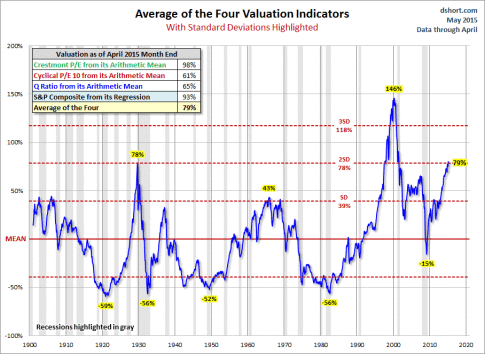– Is The Stock Market Overvalued? (Economic Collapse, May 31, 2015):
Are stocks overvalued? By just about any measure that you could possibly name, stocks are at historically high prices right now. From a technical standpoint, the stock market is more overvalued today than it was just prior to the last financial crisis. The only two moments in U.S. history that even compare to our current state of affairs are the run up to the stock market crash of 1929 and the peak of the hysteria just before the dotcom bubble burst. It is so obvious that stocks are in a bubble that even Janet Yellen has talked about it, but of course she will never admit that the Federal Reserve has played a key role in creating this bubble. They say that hindsight is 20/20, but what is happening right in front of our eyes in 2015 is so obvious that everyone should be able to see it. Just like with all other financial bubbles throughout our history, someday people will look back and talk about how stupid we all were.
Why can’t we ever learn from history? We just keep on making the same mistakes over and over again. And without a doubt, some of the smartest members of our society are trying to warn us about what is coming. For example, Yale economics professor Robert Shiller has repeatedly tried to warn us that stocks are overvalued…
I think that compared with history, US stocks are overvalued. One way to assess this is by looking at the CAPE (cyclically adjusted P/E) ratio that I created with John Campbell, now at Harvard, 25 years ago. The ratio is defined as the real stock price (using the S&P Composite Stock Price Index deflated by the CPI) divided by the ten-year average of real earnings per share. We have found this ratio to be a good predictor of subsequent stock market returns, especially over the long run. The CAPE ratio has recently been around 27, which is quite high by US historical standards. The only other times it has been that high or higher were in 1929, 2000, and 2007—all moments before market crashes.
But the CAPE ratio is not the only metric I watch. In my book Irrational Exuberance (3rd Ed., Princeton 2015) I discuss several metrics that help judge what’s going on in the market. These include my stock market confidence indices. One of the indicators in that series is based on a single question that I have asked individual and institutional investors over the years along the lines of, “Do you think the stock market is overvalued, undervalued, or about right?” Lately, what I call “valuation confidence” captured by this question has been on a downward trend, and for individual investors recently reached its lowest point since the stock market peak in 2000.
Other analysts prefer to use different valuation indicators than Shiller does. But no matter which indicators you use, they all show that stocks are tremendously overvalued in mid-2015. For instance, just consider the following chart. It comes from Doug Short, and it shows the average of four of his favorite valuation indicators. As you can see, there is only one other time in all of our history when stocks have been more overvalued than they are today according to the average of these four indicators…
Another danger sign that many analysts are pointing to is the dramatic rise in margin debt that we have seen in recent years. Investors are borrowing tremendous amounts of money to fund purchases of stock. This is something that we witnessed during the dotcom bubble, it was something that we witnessed just prior to the financial collapse of 2008, and now it is happening again. In fact, margin debt just surged to a brand new all-time record high. Once again, the following chart comes from Doug Short…
All of this margin debt has helped drive stocks to ridiculous highs, but it can also serve to drive stock prices down very rapidly when the market turns. This was noted by Henry Blodget of Business Insider in a recent editorial…
What is “margin debt”?
It’s the amount of money stock investors have collectively borrowed via traditional margin accounts to fund stock purchases.
In a bull market, the growth of margin debt serves as a turbocharger that helps drive stock prices higher.
As with a home mortgage, the more investors borrow, the more house or stock they can buy. So as margin debt grows, collective buying power grows. The borrowed money gets used to fund new stock purchases, which helps drives the prices of those stocks higher. The higher prices, in turn, allow traders to borrow more money to fund additional purchases. And so on.
It’s a self-reinforcing cycle.
The trouble is that it’s a self-reinforcing cycle on the way down, too.
If the overall U.S. economy was absolutely booming, these ultra-high stock prices would not be as much of a concern. But the truth is that the financial markets have become completely divorced from economic reality. Right now, corporate profits are actually falling and our exports are way down. U.S. GDP shrunk during the first quarter, and there are a whole host of economic trouble signs on the horizon. I am calling this a “recession within a recession“, and I believe that we are heading into another major economic downturn.
Unfortunately, our “leaders” are absolutely clueless about what is coming. They assure us that everything is going to be just fine – just like they did back in 2008 before everything fell apart. But the truth is that things are already so bad that even the big banks are sounding the alarm. For instance, just consider the following words from Deutsche Bank…
At issue is whether or not the Fed in particular but the market in general has properly understood the nature of the economic problem. The more we dig into this, the more we are afraid that they do not. So aside from a data revision tsunami, we would suggest that the Fed has the outlook not just horribly wrong, but completely misunderstood.
Ultimately, most people believe what they want to believe.
Our politicians want to believe that the economy is going to get better, and so do the bureaucrats over at the Federal Reserve. The mainstream media wants to put a happy face on things, and they want all of us to continue to have faith in the system.
Unfortunately for them, the system is failing. I truly do hope that this bubble can last for a few more months, but I don’t see it going on for much longer than that.
The greatest financial crisis in U.S. history is fast approaching, and it is going to be extraordinarily painful.
When it arrives, it is not just going to destroy faith in the system. In the end, it is going to destroy the system altogether.




The discussion of margin debt caught my attention, because I know it is a bad thing for the markets. In 1929, a person could take $100.00 and open a brokerage account and buy $190.00 worth of stock (90% margin purchase). That is 9:1 margin ratio….. As long as the market went up, all was well, but when it went down, the margin calls came, and people ran to their banks to withdraw money to save their portfolios.
At the same time, the banks were failing because they were in the system (just like now) up to their necks. The entire system collapsed, and out of that wreckage came some excellent regulations that stood us in good stead until that Clinton signed them all out of law…..in less than five years came the crash of 2000-2001..
But, back to 1929 for a moment. Before the crash, people could buy stock on margin at 90%. After the regulations were put into effect, the margin rate was cut to 50% for stocks. Bonds, which were government issue, and like cash were allowed to stay at a margin rate of 90%. That was fine until the advent of junk bonds………and bonds were no longer like cash, but greedy guts kept the rate at 90%. So, if people borrow on bonds (whatever their real value) they can margin at 90%.
Back to the present; the greedy guts covered up the dot com crash with the real estate bubble. When that broke in 2008, we never recovered….at least the real economy never recovered. The stock market has been built up by the same crooks who caused the dot com and the real estate collapse.
Looking at the chart in this article is scary……it is just a re-run of 1929. The banks no longer lend money, they simply process loans of all qualities, mix them up, process them and sell them on Wall Street as securities…..just as they did the Sub-Prime mortgages…..nothing was every fixed, no laws were ever passed to stop that outright criminal behavior.
To remind folks who may have forgotten, this is what they did. They would take loans of A+ quality, and mix in a few B and C loans to make the rate of return attractive to investors. They kept enough A quality loans to get A rating from the crooked rating houses like Moodys, but in fact, the securities were edgy at best. When the market collapsed, it was a disaster, it caused entire nations to go bankrupt…….
Nothing was done, and as a result, the world began to move away from the US….they rightfully lost trust and respect for our markets and overall credibility. The dollar has been abandoned to the use of electronic currencies in most of the world…….another subject western media won’t discuss…
When the collapse comes, the US will be a 3rd world country in entirety, not just politically. The dollar has been abandoned by Russia, China, Australia, most emerging African Nations, much of South and Central America, Canada, India, Qatar, Iran, and many other countries I cannot recall……technology has rendered the need for any world reserve currency obsolete.
Thanks to electronic currencies, nations can trade directly with each other using their own currencies, leaving the dollar out. Electronic currencies translates the value of each nation’s currency at the time of transaction, making the need for any world reserve currency obsolete. This is a huge part of what is ailing the US economy, the powerful hold of the dollar is gone in most of the world economy.
The margin buying will bring us down if nothing else does……fueled by greed, it gets insatiable when the fever is all that is left. There is no growth anywhere but in the area of debt. Nations and corporations alike build nothing else. Apple Computer, the darling of Wall Street, has $40 Billion out in bonds and just informed the SEC they are planning another huge issue. If they are doing so well, why do they need to issue more debt????
The entire system stinks…….everything is rigged, nothing is real.
Hang on, we are in for one Hell of a ride.